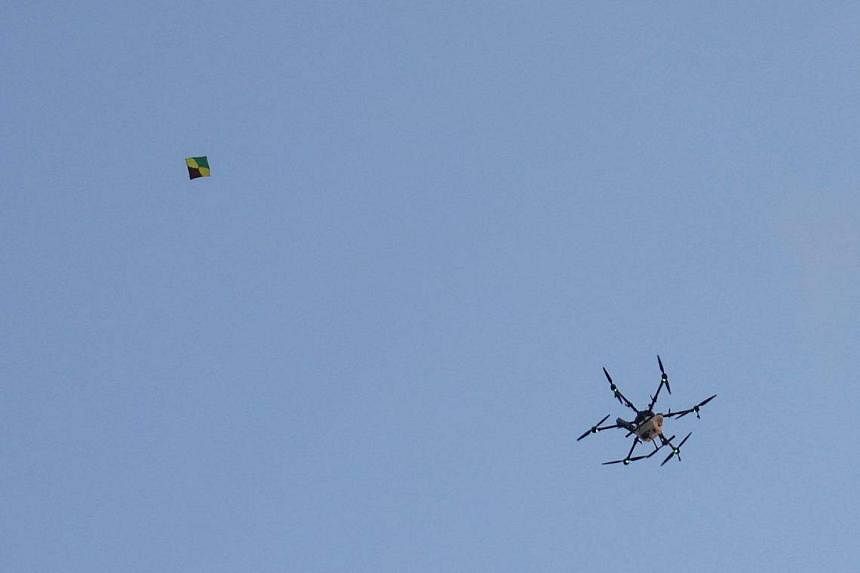NEW DELHI - India’s farmers are a vital voting bloc and have long sought greater political support to boost their incomes and cut crippling debt. Yet in recent days, security forces have been using drones to drop tear gas on them during protests – just months ahead of an election.
The tough response from the authorities came despite the government calling farmers a key focus group in the interim budget on Feb 1.
Farmers are seeking price guarantees on crops and thousands have driven their tractors and trucks, mainly from the state of Punjab, to form a long convoy to march on the capital, Delhi.
The authorities vowed to stop the “Delhi Chalo” or “Let’s go to Delhi” march, and this week, farmers clashed with security forces north of Delhi at the border between Punjab and Haryana. Farmers have used kites and other devices to ensnare the drones.
Images of the protest and clashes have circulated widely, with the government urging farmers to come to the negotiating table even as they take tough action.
On Feb 15, Agriculture Minister Arjun Munda and other government officials met farmers’ representatives for a third round of talks. Mr Munda described the talks as positive and more talks are planned for Feb 18.
Protest leader Jagjit Singh Dallewal told reporters the farmers would hold off with their march for now.
Analysts said that Prime Minister Narendra Modi and his ruling Bharatiya Janata Party (BJP), riding a wave of popularity, do not want the farmers’ issues to blow up so close to the elections, scheduled for April and May.
“The ruling party and the federal government believe they have the upper hand going into elections at the moment. They do not want this agitation to in any way deflect attention from this positive public sentiment they see as being very much there,” said Dr Sandeep Shastri, national coordinator of the Lokniti Network, a network of scholars that conducts election surveys.
“They are hoping in some ways to prevent the issue from becoming a front runner.”
The government is seeking to avoid a repeat of 2021 when a months-long sit-in by thousands of farmers in Delhi embarrassed it. Back then, the Modi government buckled to farmers’ demands, scrapping three farm laws that farmers feared would put them at the mercy of large corporations.

Historically, farmers are a group that no Indian government wants to trifle with. Seventy per cent of India’s rural households depend primarily on agriculture, making farmers an important vote bank.
At the same time, India’s agriculture, which accounts for 15 per cent of gross domestic product, is in dire need of reforms amid a failure to boost crop yield and a high dependence on unpredictable rains for irrigation. Farmers say incomes have stagnated or fallen as prices of fertilisers and seeds have risen. Most are small landholders weighed down by loans.
Their core demand is a guaranteed minimum support price for their produce. They want assurances of stable prices in addition to loan waivers. Farmers sell a lot of their produce in wholesale markets controlled by the government.
“All this calls for a revamping of the public support for farming, which is essential for reasons that include national food security,” noted an editorial in the Hindu newspaper on Feb 15, urging “wide political consultation” of their demands.
Haryana, in particular, has been tough, refusing farmers entry from Punjab as they make their way to Delhi. The BJP-ruled Haryana government, in an affidavit to the Punjab and Haryana High Court, said farmers were moving with “tractors and weapons” and “instilling fear in people”.
Analysts said this approach of talking to farmers while vilifying them might not be effective.
“This could be counterproductive. Politically, whatever be the demand, they (the farmers) have to be engaged. You can’t keep pushing them back and hope they won’t mobilise,” said Mr Nilanjan Mukhopadhyay, a Delhi-based writer and political journalist. “There is a fear (in the government) that it can become a trigger for nationwide unrest.”
However, he noted that the challenge for the farmers, coming from a state where traditionally the BJP does not have much sway, was also to attract fellow farmers from other parts of the country, including the southern and the eastern parts, to boost political pressure.

The farmers have been accused by BJP supporters of playing politics, and the protests have caused traffic jams in Delhi, angering commuters.
For the opposition Congress party, the farmers’ protest and their key demands are an opportunity to revive the party’s flagging political fortunes. Congress has promised to fulfil the farmers’ demands in its bid to stop the BJP, which is flying high, from going into a third term on the back of a highly popular prime minister.
Opinion polls, though not always accurate, have predicted a BJP win. A poll conducted between Dec 15 and Jan 28 by the India Today media group predicted the BJP and its allies would win 335 of the 543 elected seats in Parliament. In 2019, the alliance won 353 seats. The Congress alliance won 91 seats.
Dr Shastri noted it is tougher for the opposition, which is in disarray, to take advantage of the political opportunity than it is for the BJP to ride out the crisis. Congress leader Rahul Gandhi has already announced that the party, if it came to power, would give farmers a guaranteed minimum support price.
“It will be interesting to see how much the opposition is able to capitalise on the moment,” said Dr Shastri.


